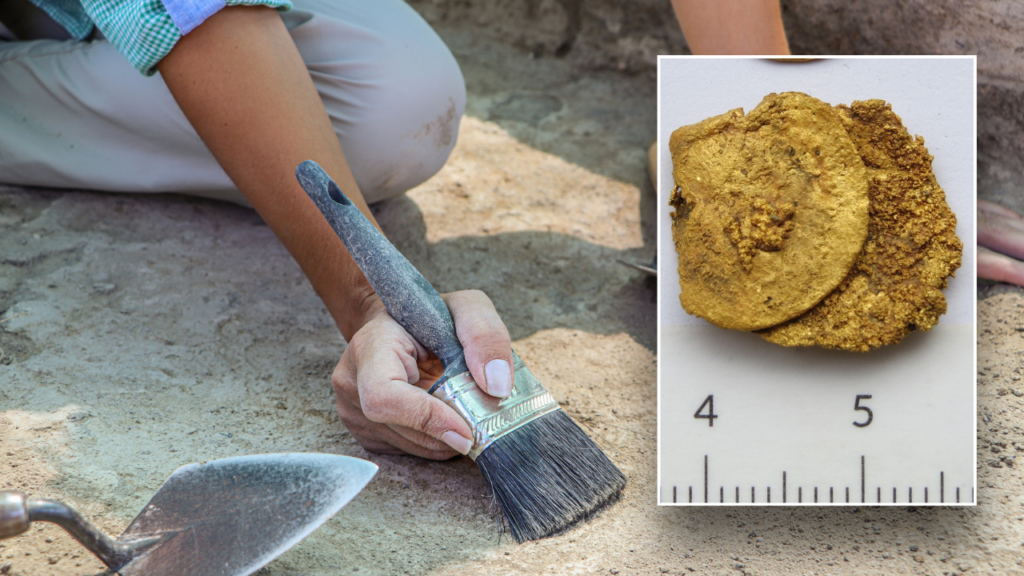In a remarkable discovery, archaeologists unveiled five ancient Byzantine gold coins during a recent excavation in Bulgaria, capturing the attention of experts and history enthusiasts alike. These coins, dating back to the reign of Justinian the Great, were found at a site in the northern Bulgarian village of Debnevo, a location steeped in historical significance. The excavation was announced by Dr. Stiliyan Ivanov, an associate professor at the National Institute of Archaeology and Museum, on August 27. This particular village is situated near a fifth-century fortress, an area that has become a focal point for archaeological activities over the past five years.
The context of the discovery is particularly intriguing, as the coins were unearthed within the remnants of a house constructed in the 10th century. This poses a fascinating chronological puzzle; the coins, originating from the Byzantine Empire, predate the structure by more than 400 years. Justinian I ruled from 527 to 565 A.D., and to find such artifacts embedded in a much later site raises questions about their journey through time. Dr. Ivanov postulated that medieval builders possibly discovered these coins while erecting the house, which was ultimately destroyed by fire later in the century. The implication is that the structure was likely abandoned soon after, suggesting a sudden and turbulent end to its history.
The significance of the coins extends beyond their mere existence. During the 10th century, these gold coins would have held considerable value, likely regarded by the residents as precious heirlooms. Thus, it is plausible that the people inhabiting the 10th-century house retained the coins even after their construction, possibly as a symbol of wealth or a connection to the illustrious past of the Byzantine Empire. With a sense of excitement, Dr. Ivanov expressed his satisfaction over the growing public interest in these ancient artifacts, emphasizing their importance in understanding the economic and cultural dynamics of that historical period.
Three of the coins unearthed were found in excellent condition, while two others were discovered fused together—likely a result of the intense heat from the fire that consumed the medieval dwelling. Each coin prominently features the visage of Justinian in its central design, along with the inscription “Our Lord Justinian Perpetual Augustus.” The reverse side further states, “Victory of the Augusts,” showcasing the grandeur attributed to Justinian’s reign. This symbolism, alongside the craftsmanship evident in the coins, highlights the technological and artistic achievements of the Byzantine period.
In conjunction with the coins, the archaeological team also recovered a variety of other artifacts, including axes, sickles, ceramic vessels, and bronze rings. While all these findings enrich the narrative of the excavation, the Byzantine coins stand out as historical gems that ignite curiosity and spark discussions about trade, economy, and societal structures during the Byzantine era.
This excavation in Bulgaria is not an isolated incident; it is part of a broader pattern of archaeological discoveries throughout the region. Earlier this summer, researchers in modern-day western Turkey uncovered ancient Greek gold coins, while in May, an individual in the Czech Republic stumbled upon an astonishing hoard of 2,150 silver coins, minted between 1085 and 1107. Such finds underscore the wealth of history lying beneath the surface of the earth, waiting to be discovered by those dedicated to unearthing the past.
As these discoveries unfold, they provide invaluable insights into ancient civilizations and their legacies. Bulgaria’s Debnevo excavation, in particular, serves as a powerful reminder of the interconnectedness of history and the importance of archaeology in piecing together the narratives of bygone eras. With the ongoing interest in such findings, it is clear that each uncovered artifact tells a story, weaving a tapestry that enriches our understanding of human history. For those eager to delve deeper into lifestyle stories and archaeological findings, further articles can be found at www.foxnews.com/lifestyle.



